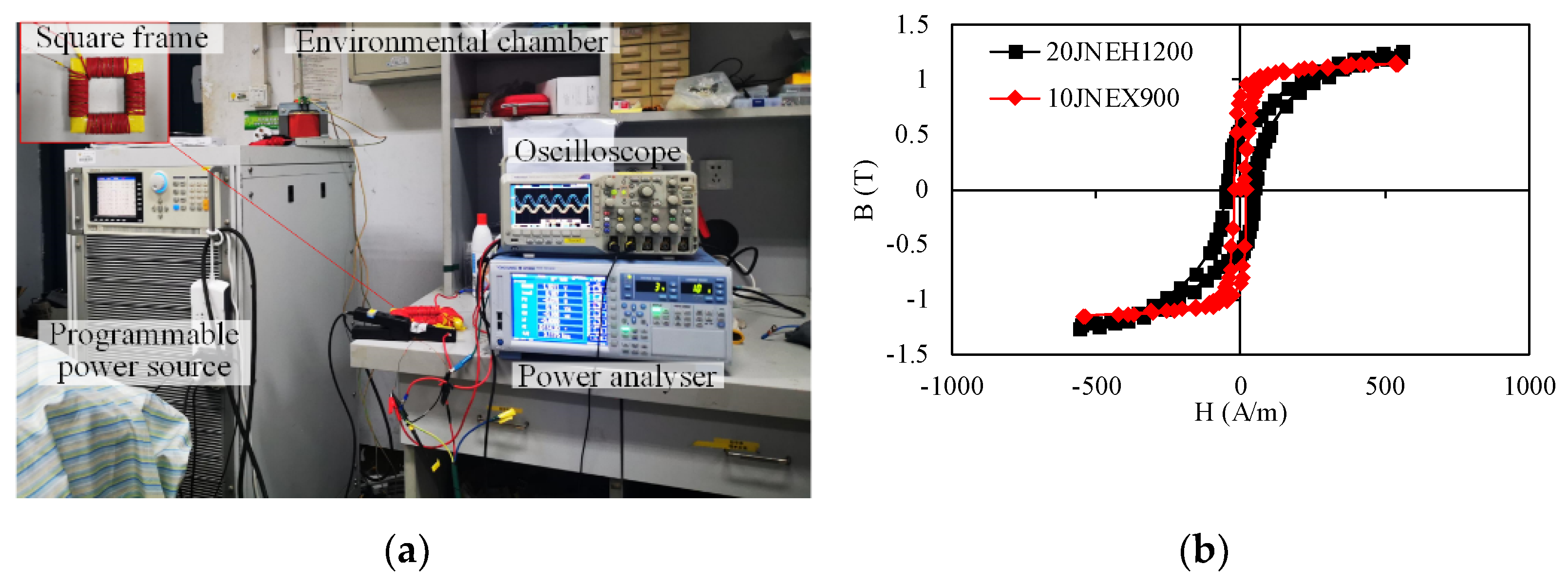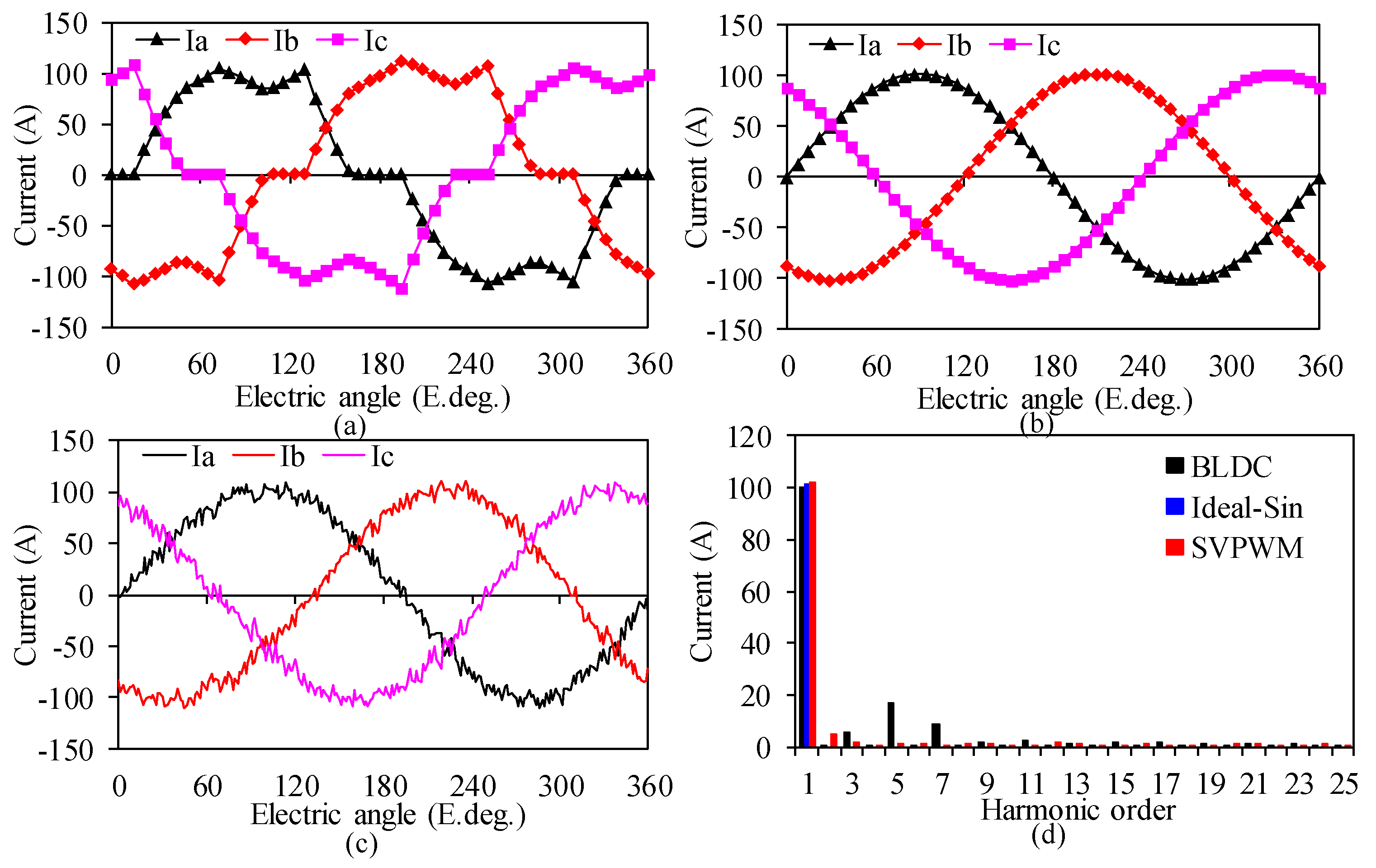High-Frequency Core Loss Analysis of High-Speed Flux-Switching Permanent Magnet Machines
Abstract
:1. Introduction
2. Machine Parameters and Core Loss Calculation
2.1. Machine Parameters
2.2. Core Loss Calculation Model
3. Calculation of Core Loss Coefficients
4. Soft Iron Material and Driver Harmonics Effects
4.1. Effects of Soft Iron Materials on Core Loss
4.2. Effect of Driving Modes on Core Loss
5. Verification
6. Conclusions
Author Contributions
Funding
Conflicts of Interest
References
- Gerada, D.; Zhang, H.; Xu, Z.; Calzo, G.L.; Gerada, C. Electrical machine type selection for high speed supercharger automotive applications. In Proceedings of the 19th International Conference on Electrical Machines and Systems (ICEMS), Chiba, Japan, 13–16 November 2016; pp. 1–6. [Google Scholar]
- Steinmetz, C.P. On the law of hysteresis. Proc. IEEE 1984, 72, 196–221. [Google Scholar] [CrossRef]
- Bertotti, G.; Boglietti, A.; Chiampi, M. An improved estimation of core losses in rotating electrical machines. IEEE Trans. Magn. 1991, 27, 5007–5009. [Google Scholar] [CrossRef]
- Zhu, J.G.; Ramsden, V. Improved formulations for rotational core losses in rotating electrical machines. IEEE Trans. Magn. 1998, 34, 2234–2242. [Google Scholar] [CrossRef]
- Štumberger, B.; Hamler, A.; Goričan, V. Accuracy of core loss estimation in induction motors by using different core loss models. J. Magn. Magn. Mater. 2004, 272, 1723–1725. [Google Scholar] [CrossRef]
- Pei, R.; Zhang, X.; Zeng, L.; Li, S. Studies of high-frequency iron core loss for synchronous electric machines used in electric vehicles. In Proceedings of the 2017 20th International Conference on Electrical Machines and Systems (ICEMS), Sydney, Australia, 11–14 August 2017; pp. 1–4. [Google Scholar]
- Liu, X.; Liu, G.; Han, B. A Loss separation method of a high-speed magnetic levitated PMSM Based on drag system experiment without torque meter. IEEE Trans. Ind. Electron. 2018, 66, 2976–2986. [Google Scholar] [CrossRef]
- Frljić, S.; Trkulja, B. Two-step method for calculation of eddy current losses in a laminated transformer core. IET Electr. Power Appl. 2020, 14, 1577–1583. [Google Scholar] [CrossRef]
- Boubaker, N.; Matt, D.; Enrici, P.; Nierlich, F.; Durand, G. Measurements Of Iron Loss in PMSM stator cores based on cofe and sife lamination sheets and stemmed from different manufacturing processes. IEEE Trans. Magn. 2018, 55, 1–9. [Google Scholar] [CrossRef]
- Al-Timimy, A.; Giangrande, P.; Degano, M.; Xu, Z.; Galea, M.; Gerada, C.; Calzo, G.L.; Zhang, H.; Xia, L. Design and losses analysis of a high power density machine for flooded pump applications. IEEE Trans. Ind. Appl. 2018, 54, 3260–3270. [Google Scholar] [CrossRef]
- Tong, W.; Sun, R.; Zhang, C.; Wu, S.; Tang, R. Loss and thermal analysis of a high-speed surface-mounted PMSM with amorphous metal stator core and titanium alloy rotor sleeve. IEEE Trans. Magn. 2019, 55, 1–4. [Google Scholar] [CrossRef]
- Ma, J.; Zhu, Z.Q. Optimal split ratio in small high speed PM machines considering both stator and rotor loss limitations. CES Trans. Electr. Mach. Syst. 2019, 3, 3–11. [Google Scholar] [CrossRef]
- Fang, S.; Liu, H.; Wang, H.; Yang, H.; Lin, H. High power density PMSM with lightweight structure and high-performance soft magnetic alloy core. IEEE Trans. Appl. Supercond. 2019, 29, 1–5. [Google Scholar] [CrossRef]
- Tong, W.; Dai, S.; Wu, S.; Tang, R. Performance comparison between an amorphous metal PMSM and a silicon steel PMSM. IEEE Trans. Magn. 2019, 55, 1–5. [Google Scholar] [CrossRef]
- Li, Y.; Cheng, H.; Lin, Z.; Deng, K.; Yang, M. A modified characterization method for core loss calculation under rotational magnetization. IEEE Trans. Magn. 2021, 57, 1–6. [Google Scholar] [CrossRef]
- Thomas, A.S.; Zhu, Z.Q.; Li, G.J. Electromagnetic loss investigation and mitigation in switched flux permanent magnet machines. In Proceedings of the 2014 International Conference on Electrical Machines, Berlin, Germany, 2–5 September 2014; pp. 1146–1152. [Google Scholar]
- Mo, L.; Quan, L.; Zhu, X.; Chen, Y.; Qiu, H.; Chau, K.T. Comparison and analysis of flux-switching permanent-magnet double-rotor machine with 4QT used for HEV. IEEE Trans. Magn. 2014, 50, 1–4. [Google Scholar] [CrossRef]
- Yuan, J.; Meng, D.; Lian, G.; Zhang, J.; Li, H.; Ban, F. The stator slot-type optimization of electrical excitation flux-switching motor and its maximum torque/copper loss control. IEEE Trans. Appl. Supercond. 2019, 29, 1–5. [Google Scholar] [CrossRef]
- Zhu, S.; Cheng, M.; Dong, J.; Du, J. Core loss analysis and calculation of stator permanent-magnet machine considering DC-biased magnetic induction. IEEE Trans. Ind. Electron. 2014, 61, 5203–5212. [Google Scholar] [CrossRef]
- Tong, W.; Li, S.; Sun, R.; Sun, L.; Tang, R. Modified core loss calculation for high-speed PMSMs with amorphous metal stator cores. IEEE Trans. Energy Conver. 2021, 36, 560–569. [Google Scholar] [CrossRef]
- Zhu, S.; Wang, H.; Zhang, J.; Lu, Z.; Cheng, M. Fast calculation of carrier harmonic loss in permanent magnet of IPMSM under PWM VSI supply over entire working range. IEEE Trans. Energy Conver. 2019, 34, 1581–1592. [Google Scholar] [CrossRef]
- Simao, C.; Sadowski, N.; Batistela, N.; Bastos, J. evaluation of hysteresis losses in iron sheets under DC-biased inductions. IEEE Trans. Magn. 2009, 45, 1158–1161. [Google Scholar] [CrossRef]
- Zhu, S.; Cheng, M.; Hua, W.; Cai, X.; Tong, M. Finite element analysis of flux-switching PM machine considering oversaturation and irreversible demagnetization. IEEE Trans. Magn. 2015, 51, 1–4. [Google Scholar] [CrossRef]
- Wang, J.; Hu, Y.; Cheng, M.; Li, B.; Chen, B. Bidirectional coupling model of electromagnetic field and thermal field applied to the thermal analysis of the FSPM machine. Energies 2020, 13, 3079. [Google Scholar] [CrossRef]








| Parameters | Values |
|---|---|
| Number of stator slots, Ps | 12 |
| Number of rotor pole pairs, Pr | 10 |
| Stator outer diameter, mm | 173 |
| Stator inner diameter, mm | 112 |
| Axial iron core length, mm | 43 |
| Number of turns/slot | 18 |
| Winding layers | 2 |
| Peak power, kW | 54.7 |
| Rated speed, rpm | 10,000 |
| Rated torque, Nm | 26.52 |
| Rated power, kW | 27.7 |
| Rated current, A | 100 |
| Current density, A/mm2 | 10 |
| Rated frequency, Hz | 1666.7 |
| Silicon steel sheet material | 20JNEH1200 |
| Permanent magnet material | N35UH |
Publisher’s Note: MDPI stays neutral with regard to jurisdictional claims in published maps and institutional affiliations. |
© 2021 by the authors. Licensee MDPI, Basel, Switzerland. This article is an open access article distributed under the terms and conditions of the Creative Commons Attribution (CC BY) license (https://creativecommons.org/licenses/by/4.0/).
Share and Cite
Yu, W.; Hua, W.; Zhang, Z. High-Frequency Core Loss Analysis of High-Speed Flux-Switching Permanent Magnet Machines. Electronics 2021, 10, 1076. https://doi.org/10.3390/electronics10091076
Yu W, Hua W, Zhang Z. High-Frequency Core Loss Analysis of High-Speed Flux-Switching Permanent Magnet Machines. Electronics. 2021; 10(9):1076. https://doi.org/10.3390/electronics10091076
Chicago/Turabian StyleYu, Wenfei, Wei Hua, and Zhiheng Zhang. 2021. "High-Frequency Core Loss Analysis of High-Speed Flux-Switching Permanent Magnet Machines" Electronics 10, no. 9: 1076. https://doi.org/10.3390/electronics10091076
APA StyleYu, W., Hua, W., & Zhang, Z. (2021). High-Frequency Core Loss Analysis of High-Speed Flux-Switching Permanent Magnet Machines. Electronics, 10(9), 1076. https://doi.org/10.3390/electronics10091076







